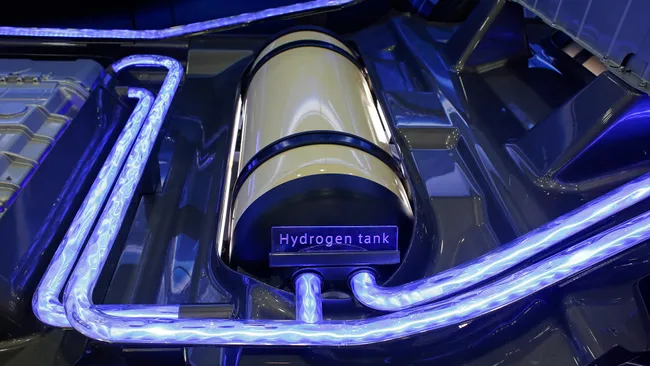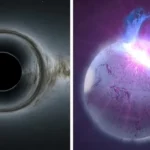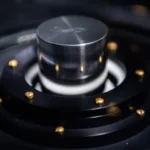Does Hydrogen Exhibit Metallic Properties?
Hydrogen is not a metal on Earth, but scientists keep trying to create metallic hydrogen under high pressure to unlock a new superconductor.
The typical answer to the question “What’s shiny and conducts electricity?” is usually a metal. However, there is an exception to this rule – hydrogen. Despite being a colorless and odorless gas, hydrogen has the potential to exhibit metallic properties under specific circumstances. This concept has been theorized by physicists since the late 1800s.
The idea of metallic hydrogen gained credibility due to its presence in various parts of the solar system. For instance, it is believed that the interior of Jupiter consists of metallic hydrogen. The immense pressure within the gas giant compresses the gas to form a superconductive metal, which generates the planet’s powerful magnetic field. However, replicating these conditions on Earth has proven to be challenging, making metallic hydrogen an elusive substance for nearly a century.
In 1935, physicists Eugene Wigner and Hillard Bell Huntington proposed in The Journal of Chemical Physics that hydrogen could become metallic under high pressures. They suggested that this transformation would occur at 25 gigapascals (GPa), which is equivalent to 250,000 times the atmospheric pressure at sea level.
However, according to Eugene Gregoryanz, a physics professor at the University of Edinburgh who specializes in extreme conditions, the actual pressure required for hydrogen to become metallic is much higher than Wigner and Huntington’s prediction. Their estimation serves as a minimum threshold for achieving a metallic state, but the reality surpasses it significantly.

Throughout the years, numerous research groups have asserted their success in creating metallic hydrogen, only to have their findings discredited due to inaccurate measurements. In 2017, a study conducted by Harvard University and published in the journal Science claimed to have produced metallic hydrogen at a pressure of 495 GPa. However, this claim was met with skepticism and sparked debates due to concerns regarding the calibration of pressure measurements, the comparison of their observations to existing models, and the lack of reproducibility. Gregoryanz, a critic of the study, pointed out that the only evidence presented were four photographs taken with an iPhone.
In 2019, another study published in the journal Nature Physics reported the discovery of semimetallic hydrogen at a pressure of 350 GPa. The study’s co-author, Mikhail Eremets, an experimental scientist in high-pressure physics, chemistry, and materials science at the Max Planck Institute for Chemistry in Germany, explained that they achieved this by subjecting hydrogen to immense pressure, resulting in a volume reduction of nearly 20 times. These high-pressure experiments were made possible through the use of a diamond anvil cell.
The technique involves loading dense hydrogen gas or liquid into a small canister and compressing it between two diamonds, which are known to be the hardest materials. Despite hydrogen consisting of only one electron, it naturally forms H2 molecules when two hydrogen atoms are held together by two unpaired electrons, forming a covalent bond. As the hydrogen molecules are compressed, the force between the atoms causes them to vibrate, similar to a spring. The frequency of these vibrations increases, indicating that the atoms are moving closer to each other.
At a certain point, the distance between the atoms becomes so minimal that the hydrogen molecules transition into a solid state. This achievement of solid hydrogen was first accomplished in 1979 at a pressure of 5.5 GPa and slightly above room temperature.
However, once the pressure exceeds 33 GPa, an interesting phenomenon occurs: the frequency actually starts to decrease, indicating that the atoms are moving apart from each other. This observation was first documented in a 1980 study published in the journal Physical Review Letters. The researchers involved in the study predicted that if the pressure continued to rise, the bond between hydrogen atoms would eventually break, resulting in the formation of a pure alkali metal with a single valence electron. Alkali metals are known for their ability to conduct electricity as they share their valence electrons within a solid structure. On the other hand, hydrogen atoms naturally form the H2 molecule, which possesses one of the strongest chemical bonds. Breaking this bond to create an alkali metal requires either extremely high pressure, such as exceeding 33 GPa, or extremely low temperatures. Alkali metals, including lithium and sodium, are positioned in group one of the periodic table, just below hydrogen. When they react with water, they form strong bases known as alkalis.
Despite the passage of more than 40 years, progress in this field has been slow. According to Eremets, conducting experiments in this area is extremely challenging due to issues such as diamond breakage, inability to reach the highest pressures, and difficulties in measuring such minuscule samples, which are only a few micrometers in size.
Nevertheless, the realization of solid metallic hydrogen may not be too far away, as suggested by Gregoryanz. His research group and others have observed a darkening of the hydrogen sample, indicating a potential closure of the “band gap.” The band gap refers to the space between the conduction zone and the valence band. In the conduction zone, electrons are able to move freely and generate electric current, as explained by the Energy Education encyclopedia from the University of Calgary.
The metallic state possesses properties that are even more intriguing than the metal itself, according to Gregoryanz. One theory suggests that hydrogen, in its metallic form, could exhibit liquid properties and potentially become a superconductor.
The development of new superconductors is crucial as current options are delicate and only function at extremely low temperatures, as stated by Eremets. Superconductors play a vital role in modern technologies like computer chips and MRI machines.
However, Gregoryanz believes that hydrogen superconductors will not be utilized in industries anytime soon due to the technological limitations in achieving pure metallic hydrogen.
Instead, many scientists, including Gregoryanz, are directing their efforts towards hydrides, which consist of a combination of a metal and hydrogen. Although these samples are still small in size, hydrides have the ability to form superconductors that operate under significantly lower pressures compared to pure hydrogen. Nevertheless, these pressures are still too high for practical industrial use, Gregoryanz explained. “But as a physical phenomenon, it’s absolutely fascinating,” he added.





0 Comments